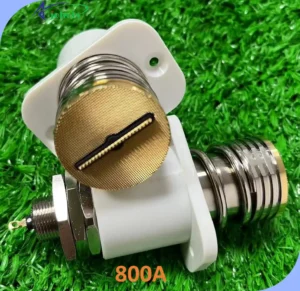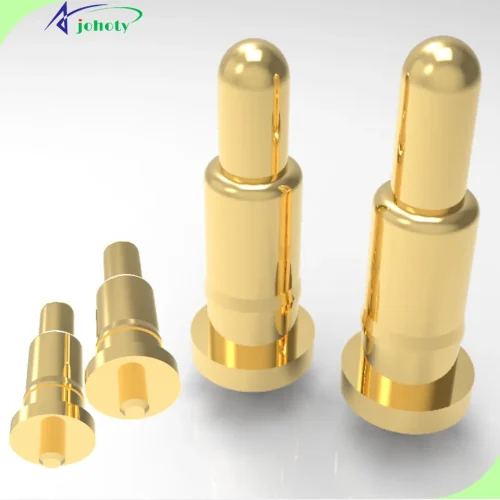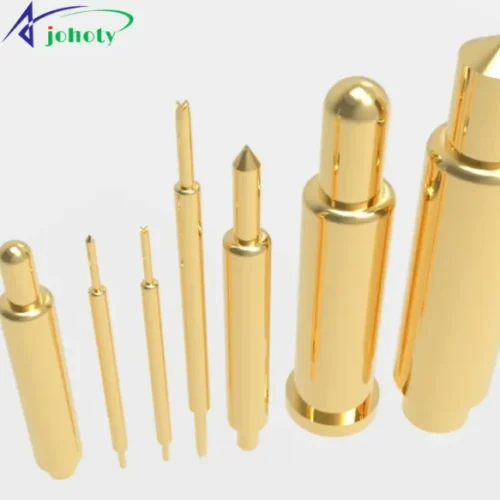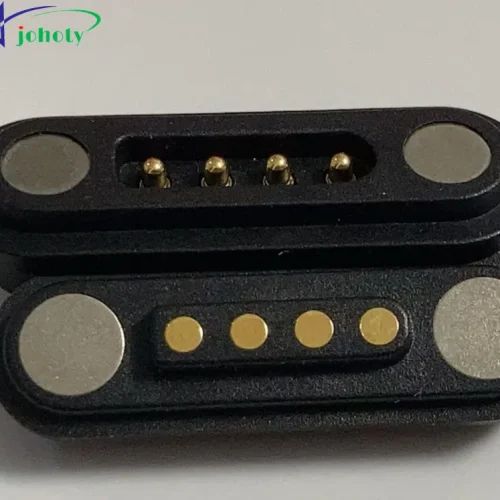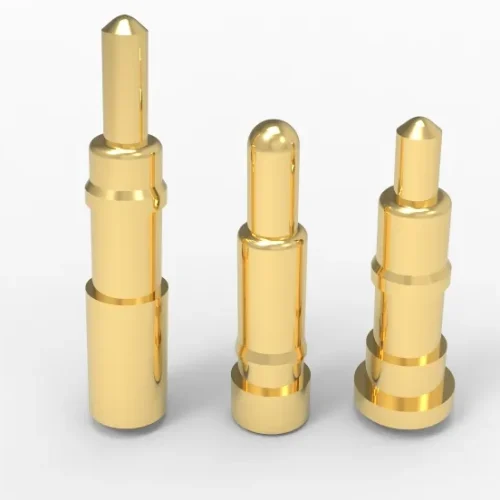Discover the best materials and designs for high-current Pogo Pins for companies. Learn how materials can enhance the quality and services!
Material selection is critical for high-current pogo pins to maintain the highest quality and stability. Material selection is critical for high-current pogo pins to maintain the highest quality and stability. Good materials can directly determine the performance of pogo pins. Can maintain high-current pogo pins at high temperatures without embrittlement. And can make sure the temperature rise is in the range of <20℃.
The ideal material selection should optimize cost without sacrificing performance and reliability. Develop an in-depth understanding of each material’s properties and their impact on Pogo Pin performance. This empowers you to make better-informed choices to deal with the requirements of your distinct application. Therefore, You’d think about the balance between performance, reliability, and cost-effectiveness when selecting materials for high-current Pogo Pins.
Importance of material selection for you
Material selection is very critical. It has a direct impact on the performance, dependability, and cost-efficiency of high-current pogo pins, as well as your devices and equipment. The material is related to your ability to obtain high-quality high-current pogo pins and services. It has a direct bearing on your organization’s brand prestige and market competitiveness.
Proper material selection can extend pogo pins’ life cycle and reduce maintenance costs while providing superior electrical performance. Good materials can significantly improve the performance, cost-effectiveness, reliability, and durability of high-current pogo pins. Decreasing the comprehensive carbon impact of a product. And, meets increasing environmental requirements and enhances your corporate image. Comply with strict international standards and regulations, such as RoHS or REACH. This will avoid legal risks and potential market restrictions. Effect of selecting material on the efficiency of high-current pogo pins.
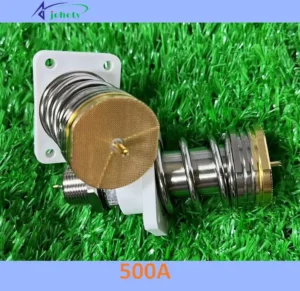
-
Electrical conductivity
The electrical conductivity of a material directly affects the current transfer efficiency of the high-current Pogo Pin. Selecting materials with high conductivity, such as copper alloys or precious metal coatings. It can reduce energy loss and improve overall performance.
-
Contact impedance
The contact impedance of a material affects signal integrity and power transfer. Low contact impedance means better signal transmission and less heat generation. This is critical for high-frequency applications and high-current transmission.
-
Resilience and wear resistance
Higg-current Pogo pins need to have good spring force and abrasion resistance to maintain long-term physical contact performance. Material selection is to balance elasticity and hardness to avoid excessive wear or deformation.
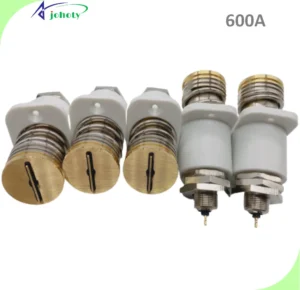
Influence of material selection on the reliability of high-current pogo pins
-
Corrosion resistance
It is critical to maintain a reliable connection of the high-current Pogo Pin over the long term. In corrosive environments, such as high humidity or the presence of chemical gases. A material with high corrosion resistance can significantly improve the stability and longevity of the connection.
-
Environmental adaptability
Different environments require high-current Pogo Pin material to have different physical and chemical properties. For example, high-temperature environments require a material featuring a high melting point and robust thermal steadiness.

Significant impact of material selection on the cost of high-current pogo pins
-
Material costs
The material’s cost directly contributes to the total cost of the high-current pogo pins. Although valuable metals like gold and silver provide superior conductivity and resistance to corrosion, they come at a higher price. Choosing a cost-effective material, such as a copper alloy, may reduce costs while meeting performance needs.
-
Manufacturing costs
The machinability of a material affects manufacturing costs. Materials that are easy to machine can streamline the production process. And, it can also reduce manufacturing time and costs.
-
Maintenance costs
Choosing durable and low-maintenance materials can reduce long-term maintenance costs. The durability and reliability of the material directly affect the maintenance intervals and replacement frequency of the product.

Differences and characteristics between a high-current Pogo Pin and a standard Pogo Pin
The choice between a high-current Pogo Pin or a standard Pogo Pin depends on the specific needs of your application. This includes current carrying capacity, operating environment, and the best price. Understanding the differences and characteristics of these two types of Pogo Pins. It will help you make the right requirements and choices during your designs, innovation, and manufacturing. This ensures that your connection solution is both efficient and reliable.

Design Differences
- Size and Construction: To support higher current transfer, high-current Pogo Pins typically have larger dimensions and stronger structures than standard Pogo Pins. This includes thicker pins, larger spring diameters, and thicker plating. Which can minimize contact resistance and increase durability.
- Materials: High-current Pogo Pins focus more on conductivity and heat resistance when selecting materials. Commonly used materials include highly conductive copper alloys or silver alloys, etc. Gold or silver plating may be used to further minimize contact resistance.
- Contact Design: To increase current carrying capacity and reduce contact resistance. High-current pogo pins often utilize special contact designs. Such as multi-point contacts or designs that increase the contact area.
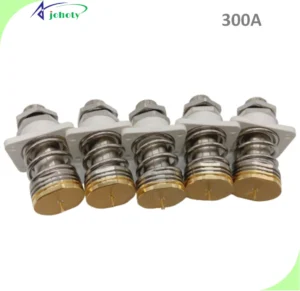
Performance Differences
- Current Carrying Capability: The most significant difference is that High-Current Pogo Pins can safely carry much higher currents than Standard Pogo Pins. High-current pogo pins can carry currents in the range of a few amperes (A) to tens of amperes. We are capable of supplying pogo pins with a high current of up to 800 amps. whereas Standard Pogo Pins are for signaling or lower current power connections.
- Thermal Resistance: Because high-current transmission generates more heat, high-current pogo pins typically have better thermal resistance. and they can operate at higher operating temperatures.
- Durability: High-current Pogo Pins typically exhibit better durability and reliability in high-load applications and frequent mating. Because they have optimized design and materials.

Application Differences
- Applications: High-current Pogo Pins are commonly used in applications that require high-current transmission. Such as battery chargers, power tools, certain industrial equipment, Giga factories, and aerospace, etc. Standard Pogo Pins are more commonly used for low-current signaling applications. Such as data communications, charging of low current, sensor connectivity, mobile devices, and so on.
- Cost: High-current pogo pins come at a higher price compared to standard pogo pins. Because of the higher requirements in design, materials, and manufacturing processes.

Material selection: Key considerations for a high-current pogo pin
Including electrical conductivity, mechanical strength, corrosion resistance, abrasion resistance, high-temperature resistance, cost-effectiveness as well as environmental and safety criteria. This ensures that the materials you select will completely meet the requirements of your specific application. Providing you with connection solutions of high performance and long-term reliability.
Conductivity
Material conductivity is a critical determinant in the electrical functionality of a pogo pin. Highly conductive materials such as copper alloys, and silver or silver-plated copper. They can greatly reduce contact resistance and increase current transfer efficiency. This is especially important for high-current Pogo Pins, which are required to carry higher currents.
Mechanical Strength and Elasticity
The materials’ resilience and mechanical strength always affect the durability and longevity of the pogo pins. Choosing a material with good elasticity ensures that Pogo Pins maintain stable contact pressure during multiple plugging and unplugging. While good mechanical strength prevents deformation under high loads.

Corrosion Resistance
This consideration is vital for the prolonged stability of high-current pogo pins. In high humidity or chemically aggressive environments. The corrosion resistance and durability of Pogo Pins can be improved. By selecting corrosion-resistant materials or through surface treatments such as gold plating.
Wear resistance
This becomes especially important for frequent usage. Material and surface treatment can minimize contact wear and extend the life cycles of the Pogo Pin.
High-Temperature Resistance
In high-current applications, Pogo Pins may generate a high-temperature rise. So, it’s imperative to pick the appropriate material resilient to high thermal conditions. This includes selecting materials with high melting points and good thermal stability. It is to prevent performance degradation or physical damage at high temperatures.

Cost Effectiveness
While performance and reliability are primary considerations, cost efficiency is likewise a crucial consideration. The selection of a cost-effective material can help control your production costs. It helps improve the marketability of your equipment provided that the application requirements are met.
Environmental and health and safety standards
Material selection also needs to consider compliance with EHS standards, such as RoHS and REACH. This is to ensure that each product complies with the regulatory requirements of the global market.

Comparison of common material and properties for high-current Pogo Pins
High-Current Pogo Pins are responding to the need for high-current transmission. Their material selection is critical to ensure their performance, reliability, and durability. For example, Beryllium copper is irreplaceable in high-performance applications. Phosphorus copper, on the other hand, offers a cost-effective option
Copper Alloy
- Electrical Conductivity: Copper alloys are widely used in electrical connectors, including high-current pogo pins, for their excellent electrical conductivity. Only silver outperforms copper in electrical conductivity. Which is effective in diminishing electrical resistance and the generation of heat.
- Mechanical Properties: Copper alloys also offer good mechanical strength and elasticity for frequent mating.
- Corrosion Resistance: Relatively good, but may oxidize in some environments. plating can be used to improve corrosion resistance, e.g. gold or silver.
- Cost: Copper alloys are relatively low cost compared to precious metals, but higher than stainless steel.

Beryllium Copper
- Electrical Conductivity: Provides good electrical conductivity, not as good as pure copper, but adequate for high current pogo pins.
- Mechanical Strength and Resilience: Beryllium copper is distinguished by its high strength and excellent elasticity. It can retain its shape and elasticity under extremely high stress. This makes Beryllium Copper an ideal material for making highly durable and long-lasting high-current Pogo Pins.
- Corrosion Resistance: This material exhibits notable corrosion resistance. Enabling its application in various settings without degradation for a long time.
- Heat Treatment and Workability: It can be heat treated to significantly increase its strength and hardness: But it is difficult to machine, especially after hardening.
- Cost: Due to the high price of beryllium and the complexity of machining, the cost of beryllium copper is relatively high.

Phosphor Copper
- Electrical Conductivity: Provides good electrical conductivity, slightly less than Beryllium Copper, but adequate in most cases.
- Mechanical Strength and Resilience: While phosphorus copper is stronger and more resilient than pure copper, it is usually inferior to beryllium copper. Phosphorus copper performs well in general applications. But may not perform as well as beryllium copper under extreme conditions.
- Corrosion Resistance: It exhibits enhanced durability against corrosion, particularly in arid conditions. However, additional protection may be required in certain corrosive environments.
- Heat Treatment and Workability: Relatively easy to process, although the addition of phosphorus improves hardness. It still maintains good processing performance.
- Cost: Lower cost than Beryllium Copper, providing a viable option for applications requiring a more cost-effective solution.

Tellurium Copper
- Electrical Conductivity: Tellurium Copper’s electrical conductivity is superior to that of phosphor bronze and is close to that of pure copper. This makes it suitable for connection applications where outstanding electrical qualities are essential.
- Mechanical Strength and Resilience: Although not as strong or resilient as Beryllium Copper, it is adequate for most electrical connection applications.
- Corrosion resistance: good corrosion resistance, fit for deployment in multiple environments.
- Machinability: The addition of tellurium significantly improves the machinability of copper. This makes TeCu one of the best copper alloys for machining, especially for complex shapes of Pogo Pins.
- Cost: The cost of tellurium copper is in between that of copper beryllium and copper phosphorus. It achieves a perfect blend of cost and performance.

Stainless Steel
- Electrical Conductivity: Stainless steel has poor electrical conductivity and is not a preferred material for high-current Pogo Pins. But It can be used in housings, support structures, and standard pogo pins.
- Mechanical Properties: Provides extreme strength and durability, especially when exposed to intense heat and rigorous environments.
- Corrosion Resistance: Excellent corrosion resistance for long-term use.
- Cost: Relatively inexpensive, especially when corrosion resistance and mechanical strength are major considerations.
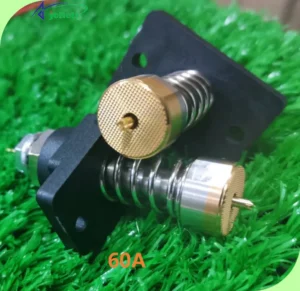
Precious metal plating: gold, silver
- Electrical Conductivity: Gold and silver plating provide very good electrical conductivity. In particular, silver has the best electrical conductivity of any metal.
- Corrosion Resistance: Gold coatings provide excellent resistance to corrosion and oxidation. This qualifies them for applications in need of a consistent connection for the long term. Silver, while better conductive, is relatively easy to oxidize. It may require special environmental conditions or protection.
- Abrasion resistance: Precious metal coatings also improve the abrasion resistance of the contact interface, extending service life.
- Cost: Precious metal coatings significantly increase the cost. However, in those demanding applications, the performance benefits are often worth the investment.

Precious metal coating: Platinum, Palladium, Rhodium-Ruthenium
Platinum (Pt)
- Electrical Conductivity: Platinum has good electrical conductivity although not as good as silver or copper. It remains stable in high-temperature environments, well-suited for environments requiring thermal resilience.
- Corrosion resistance: Platinum’s greatest strength is its excellent corrosion resistance. It is stable against almost all chemicals. This makes it particularly suitable for chemical environments or applications requiring long-term stability.
- Mechanical Strength: Platinum has a higher mechanical strength compared to silver or copper. However, it is lower than beryllium copper.
- Cost: Platinum stands as one of the most high-priced precious metals. So, its high cost often limits its use in cost-sensitive applications.
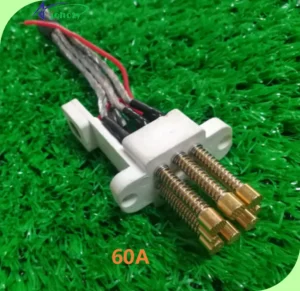
Palladium (Pd)
- Electrical conductivity: Palladium has good electrical conductivity for electrical connections. But again, not as good as silver and copper.
- Corrosion resistance: Palladium has very good corrosion resistance, although slightly less than platinum. But it performs well in most environments.
- Mechanical Strength: Palladium has moderate mechanical strength. It fits applications needing corrosion resistance and specific mechanical properties.
- Cost: Palladium is slightly less expensive than platinum, but is still a higher-priced material.

Rhodium-Ruthenium Alloys (Rh-Ru)
- Electrical conductivity: Rhodium-ruthenium alloys have good electrical conductivity for most electrical connections.
- Corrosion resistance: Rh-Ru alloys offer excellent corrosion resistance, especially in extreme environments. Like elevated temperature conditions or corrosive chemical surroundings.
- Mechanical strength: Rhodium-ruthenium alloys are mechanically strong. It can withstand high mechanical stress and wear, thereby making it appropriate for challenging applications.
- Cost: Rhodium and ruthenium are both very rare precious metals. This makes rhodium-ruthenium alloys very costly and usually only used for specialized applications.

Use case of material selection
Background:
A leading global electric vehicle (EV) manufacturer was facing the challenge of designing a high-performance, high-durability connectivity solution. Which is for the battery charging system of their latest generation of EVs. This connection system supported fast charging capabilities and maintained reliability in a variety of environments. including conditions of intense heat, profound humidity, and minimal temperature.
Requirements:
- High current support: The charging system needs to support currents up to 200A for fast charging.
- Resistant to environmental effects: The connectivity system is required to perform within the temperature range from -20°C to 120°C. and resist corrosion caused by humidity and salt spray.
- Durability: Considering the lifespan of an electric vehicle, the connection system needs to guarantee a minimum of 10,000 cycles of plug.
- Cost Effectiveness: Effectiveness and trustworthiness are the main concerns. How its cost control is also necessary to keep the final product competitive in the marketplace.

Material Selection
Considering the above requirements, our team evaluated the following materials:
-
Beryllium copper
Benefits include extremely high strength and flexibility, notable corrosion resilience, and fair electrical conduction. Thus, making it suited for uses where enduring robustness is essential. However, beryllium copper alloys are relatively costly.
-
Copper Phosphorus
Provides good electrical conductivity and adequate mechanical strength at a lower cost than beryllium copper. Although phosphorus copper has good corrosion resistance. It may not be as good as beryllium copper under extreme conditions.
-
Telluride copper
Telluride copper is considered for their excellent workability and good electrical conductivity. While their durability and corrosion resistance are moderate. They are less costly and suitable for cost-sensitive applications.

The Solution
Ultimately, the team decided to use a phosphor copper as the primary connector material. Merged with gold plating, this approach was taken to fortify its corrosion resistance and decrease the contact resistance. This combination met all performance requirements. Including high current transfer, good environmental resistance, and adequate durability. At the same time, the cost of the phosphorus copper alloy was more reasonable than that of the beryllium copper. This helped to control the cost of the entire system.
Results
The high-current Pogo Pin with phosphor copper performs well in electric vehicle charging systems. It supports the fast-charging function and maintains high reliability and performance stability over a long time. In addition, by optimizing the material selection, we have successfully balanced performance and cost. It also makes our customer’s new generation of electric vehicles ultra-competitive in the market.

Supply chain and cost management of material selection for high-current pogo pins
We effectively manage the supply chain and control costs while ensuring the performance and reliability of high-current Pogo Pins. This helps improve the market competitiveness of our guests’ products and helps enhance customers’ profitability and sustainability.
Material Selection and Supply Chain Management
Diversified Suppliers
– For critical materials such as copper alloys, beryllium copper, or precious metal plating materials. We always establish a diversified supplier network. This reduces the risk of a problem with a single supplier affecting the entire production line.
Long-Term Relationships
We prefer to establish long-term relationships with suppliers. It can facilitate better price negotiations and a more reliable supply chain for raw materials. Suppliers can also offer us price concessions or more flexible supply terms once a stable demand has been identified.

Quality control and standardization
When selecting a material supplier, we always insist their products meet international standards and quality control requirements. Such as ISO certification. This is critical to ensure the performance and reliability of high-current pogo pins.
Inventory Management
Successful inventory regulation tactics, such as implementing Just-In-Time (JIT) systems or keeping stock at minimal levels. This can reduce inventory costs and the risk of obsolescence. At the same time, we always ensure the stability of material supply.
Material Cost Optimization
Ensuring performance, select the most cost-effective material by comprehensively evaluating the performance and cost of different materials. For example, consider using alternative materials with similar performance but lower cost.
Manufacturing Process Optimization
Optimizing the manufacturing process can curtail material excess and heighten work output. For example, reduce costs by improving processing techniques or adopting more advanced manufacturing equipment.

Design Optimization
Design optimization reduces material usage without sacrificing product performance. For example, optimizing the size and shape of a Pogo Pin through computer simulation and testing. It is to reduce the use of valuable material.
Total Cost of Ownership (TCO) Analysis
We also use the TCO approach when considering material and manufacturing costs. This includes consideration of direct costs, such as material and manufacturing costs. And indirect costs, such as maintenance, replacement, and downtime costs.

Future and innovation of material selection for high-current pogo pins
With rapid developments in areas such as wearables, 5G communications, and electric vehicles. The performance requirements for high-current Pogo Pins are becoming even more demanding. Future material choices will need to balance performance, cost, environmental protection, and technological innovation. At, they will be able to adapt to these rapidly changing needs. In addition, global awareness of sustainable development and environmental protection has increased. The application of eco-friendly and sustainable materials will become an important trend in future material selection.
Application of advanced material
- High-performance alloys: Develop new high-performance alloys, such as improved beryllium-copper alloys. This is to provide higher elasticity, electrical conductivity, and anti-corrosion properties while lessening weight.
- Nanomaterials: Utilize nanotechnology to improve material properties, such as nano-coatings. This is to enhance electrical conductivity and abrasion resistance and reduce internal impedance.

Eco-friendly material
- Green Manufacturing: Cultivating and implementing more environmentally benign materials and fabrication processes. This is intended to diminish the use of toxic substances. For example, finding lead-free alternatives to meet global environmental regulations.
- Recyclable Materials: Promote the use of recycled or reclaimed materials in the manufacture of Pogo Pins. This is intended to mitigate the influence on the ecosystem.
Cost management innovation
- Material cost optimization: Finding a lower-cost alternative material through material science innovation. This aims to lower expenses without dropping performance.
- Manufacturing technology advancement: Adopting automation and lean manufacturing. This is to reduce waste and increase productivity.

Intelligent and adaptive technologies
- Integrated Sensors: Integrate miniature sensors into high-current Pogo Pins to monitor connection status and performance in real-time. For example, our temperature sensor. This is to predict and prevent failures.
- Adaptive material: Develop smart materials that can automatically adjust their performance according to environmental conditions. For example, temperature, and pressure. This is to improve the reliability and longevity of the connection.
Sustainability and Recyclability
- Recycling: Emphasizing the recycling of the high-current Pogo Pin and its materials. The design accounts for the entire lifecycle of the product, from its inception to its recycling phase.
- Reduced energy consumption: Research and development of more efficient materials and designs. This is to reduce energy consumption during use, especially in electrical connections to reduce heat loss.

Conclusion
The material selection for high-current Pogo Pins is an approach that collectively assesses various elements. New raw materials, technology, and market trends need to be constantly evaluated. This is to ensure that they meet current and future performance requirements. While meeting cost and environmental goals.
It is very key to select the material that provides optimal electrical performance and mechanical durability. This can ensure that Pogo Pins work reliably in a variety of applications. We have consistently used advanced manufacturing techniques, optimized designs, and explored cost-effective alternative materials. We always effectively control the costs without sacrificing quality.

Future material and cooperation
As technology advances, the future material will focus more on intelligence, adaptive capabilities, and integration of advanced functions. Such as integrated sensors and self-healing capabilities to adapt to increasingly complex applications.
As environmental protection laws become more stringent and public consciousness about environmental preservation grows. The emphasis on utilizing sustainable and eco-conscious materials intensifies.
We initiate long-standing relationships to create tailored solutions. Believe us to be your solid partner and together we quickly adapt to market changes and technological developments.

